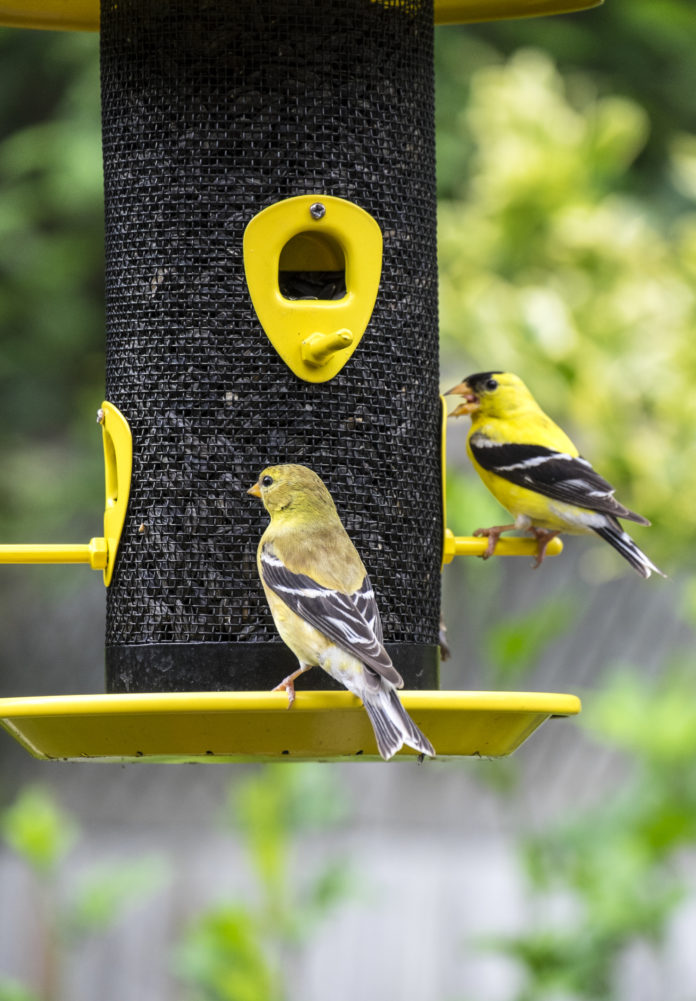
The birds could very well live without us, but many, perhaps all, of us would find life incomplete, indeed almost intolerable without the birds. –Roger Tory Peterson (naturalist, ornithologist, and author of A Field Guide to the Birds)
In the summer, when foliage is lushest, unless we wake up at the crack of dawn when their singing is the loudest, it is easy to forget that our fine feathered friends surround us, hidden in the safety of trees and shrubs. But when winter arrives, it easier to spy songbirds lurking in the outdoor spaces, in the bare naked trees, that surround our homes, as they scour our gardens for food.
Although wild birds are entirely capable of fending for themselves when it comes to feeding and housing, winter does sometimes present complications for them that can be eased by human intervention through backyard feeding. Feeding birds happens to be a symbiotic relationship: if we are diligent in our bird feeding habits, they will repay us by giving us hours of activity to observe their antics, and we can expand our knowledge about bird behavior and the natural world. Feeding birds can be a hobby for the whole family to enjoy, from picking out the feeders, to buying the food, filling and refilling the feeders, chasing away pests, watching and identifying feathered wildlife.
Attracting birds
The environment you establish will determine the number and types of birds that visit your home. The type of feeders you have as well as the food you provide can make a difference in attracting different species. Hygiene of the feeders, availability of water, access to housing, can all make a difference in the bird world.
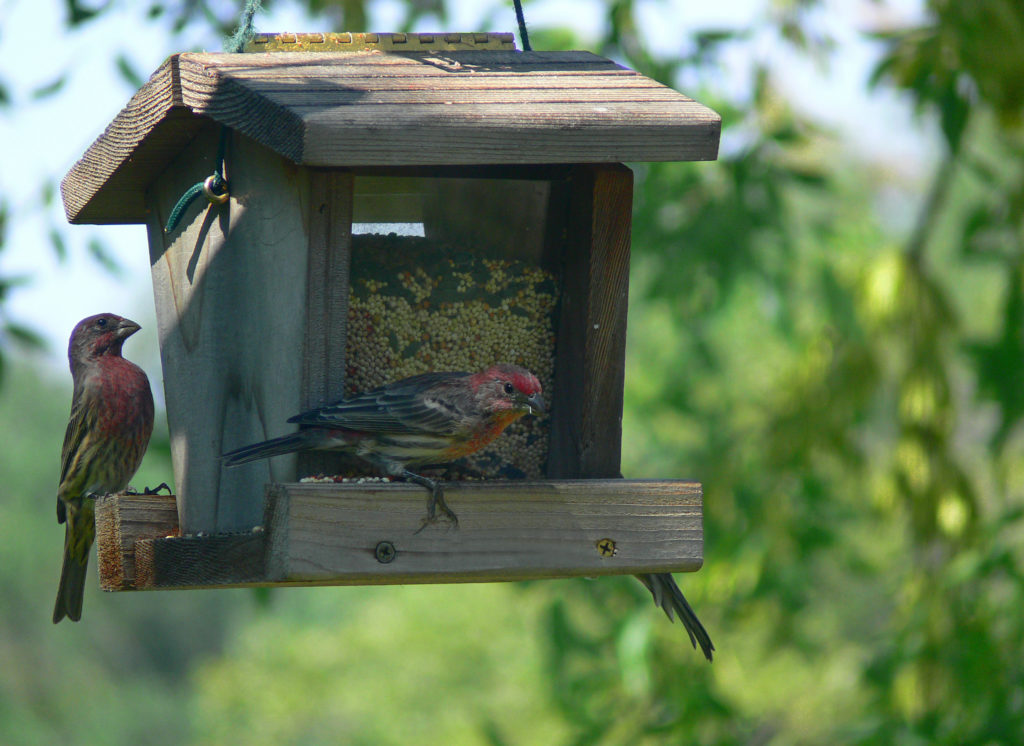
Types of feeders
The number one way of attracting birds to your yard is to FEED THEM! Different birds prefer different types of feeders and different types of food, so you may need to consider slowly investing in various supplies as you progress in your hobby.
- The Ground: the easiest and cheapest way to feed birds is simply by spreading seeds on the ground for them to find. Various species, such as sparrows and doves, actually prefer feeding on large flat surfaces rather than precariously perched up high on a feeder. To make it easier to find, you could start by spreading the seeds on top of a picnic table.
- Platform feeder: A raised flat surface where the food just sits where you put it. This is an alternative to ground feeding. Just make sure there are plenty of drainage holes to allow water to run off. You will also probably want to place this lower to the ground than the other types of feeders that follow.
- Large Hopper/Small Hopper: These are both based on the same principle: a large central housing that protects the food but is surrounded by a platform onto which the food falls, where birds can sit and eat. A large hopper will be comfortable for larger birds such as grackles and doves, but if you prefer to attract smaller birds, consider a small hopper feeder
- Large Tube/Small Tube Feeder: Although they come in different sizes, the principal of these tube feeders are the same. Essentially, tube feeders are plastic cylinders with multiple feeding ports and perches to accommodate multiple birds at the same time. Keep in mind that different sized perches will attract differently sized birds. You may want multiple of these feeders depending on what kind of birds you want to attract.
- Nectar Feeder: These are exclusively used for dispensing nectar for hummingbirds, who should only be fed during the warm months. It is important with these feeders to change the nectar regularly and clean the feeder thoroughly throughout the season.
- Suet Cage: A detailed description of suet follows, but in order to properly dispense suet a suet cage is needed to hold it in place and make it accessible to hungry birds. Some bird feeders are now created with suet cages incorporated into their design, negating the need for a separate cage.
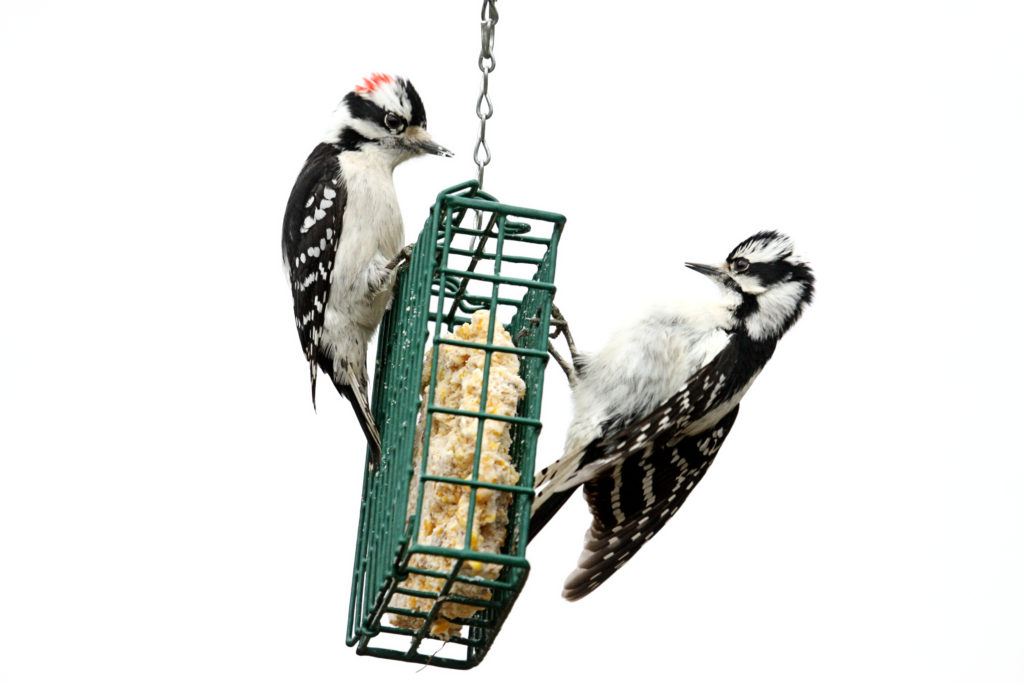
Types of food
Like most creatures, certain birds have individual preferences when it comes to what they prefer to eat. Make sure you store the food tightly sealed in a location where little rodents cannot infiltrate.
- Seeds/grains
- Sunflower seeds (both whole and hulled): The most common of birdseed in North America and a favorite of cardinals, chickadees, finches and sparrows.
- Millet: This is a tiny round seed that is a favorite of birds who like to ground feed, such as juncos and sparrows
- Milo: This is often used as a filler in cheaper bird foods and is not enjoyed by many species. If you can, avoid buying birdseed with milo in it.
- Nyer: More commonly known as thistle seed, nyer actually comes from a plant native to Africa. Finches are highly attracted to nyer, which requires a special feeder because of the tiny size of the seed. Nyer is also best used in isolation from other seeds. If you want to attract finches, get a specialized feeder only for nyer seed.
- Oats: Enjoyed by many species of birds and included in many mixes. Doves and quails particularly enjoy oats.
- Peanuts: Only use unsalted peanuts, either in the shell or out of the shell to be enjoyed by many birds varieties, but stay alert for mold
- Safflower: While this seed is eaten by large billed birds, such as cardinals, most species prefer sunflower seeds over safflower.
- Fruit: Fresh or dried, many birds find fruit to be a treat. From orioles who love to snack on the meat and flesh of oranges, to robins and bluebirds who like raisins, consider fruit an option to make your feeders more appealing. But again, be on the lookout for mold as the toxins from fruit mold can be toxic to birds.
- Suet: Suet is a fat rendered from beef kidney’s. It is inexpensive and highly valued by insect eating birds and is especially helpful in cold weather. In the summer, it is hard to keep suet because it tends to melt and go rancid in the heat. But in the cold months, suet provides necessary energy to many birds. Various woodpeckers especially seem to enjoy suet.
- Mealworms: Dried (or fresh!) meal worms provide a high protein treat for many birds. These larvae are particularly attractive to bluebirds, chickadees, titmice, wrens, and nuthatches.
- Hummingbird Nectar: One part sugar to 4 parts boiling water. And please, do not add red dye.
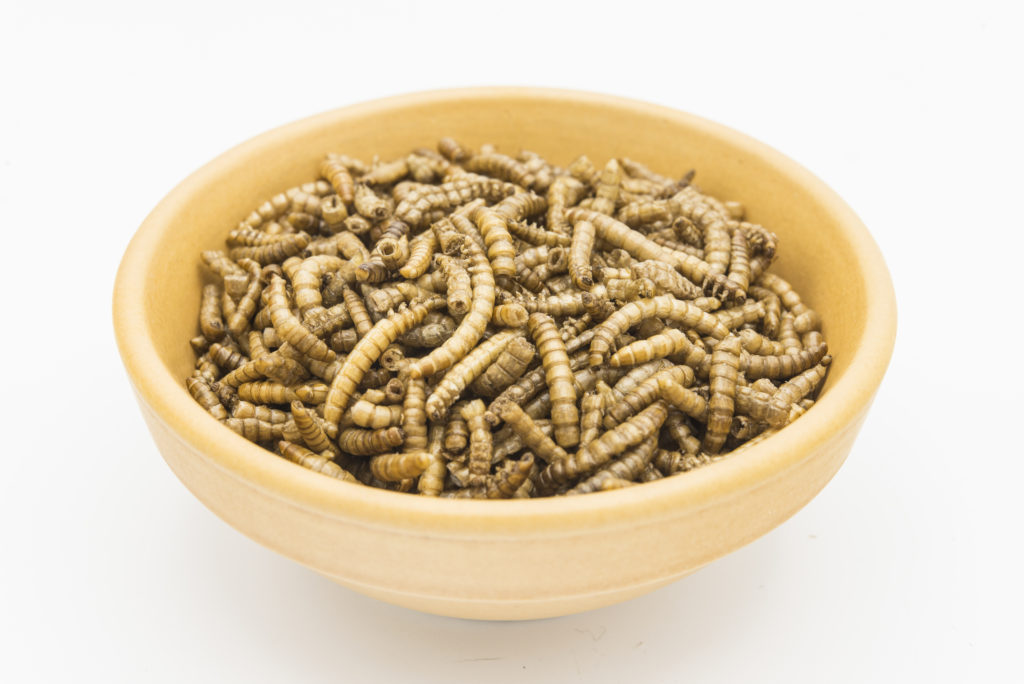
Bird feeder hygiene
- For nectar feeders, it is extremely important to clean the feeder everytime you replace the nectar.
- As mentioned above, keep an eye out for mold that can accumulate from nuts and fruits. If you notice mold, you will want to empty out all of the food and give the feeder a good scrubbing. Let dry thoroughly before refilling.
- You will also notice that the ground beneath your feeders will get messy with feces and hulls. No one likes to dine in such circumstances. Be a good host, and occasionally clean up the mess beneath your feeders.
- If you have multiple feeders, spread them far enough apart that the birds don’t crowd one another. No one likes to sit elbow-to-elbow with strangers at a restaurant.
Identifying Birds
From books, to websites, to apps, you have many options when it comes to resources for helping you to identify the various types of birds that appear in your backyard. As your hobby grows, so will your list of references, and you will probably find that you want to keep something with you at all times so you can identify birds wherever you encounter them.
Books
The definitive book on bird identification is A Field Guide to Birds by Roger Peterson, which is available from various booksellers. If you want to see what other options are available, check out the different published field guides from your local library to see which format suits your personal preferences best.
Websites
Birdwatching websites abound, from the National Audubon Society (which is near and dear to our hearts as John James Audubon himself lived in the tristate city of Henderson, KY), to the American Birding Association, among numerous others.
Apps
In the 21st century, we are lucky to have birdwatching apps we can keep on our smart phones. This is super convenient so that we can identify birds wherever we go. Apps also allow you to search for birds by song and help you keep track of birds you have found. While some of these apps are free, others will cost you a little bit of money, but no more than a book might cost, and will provide you with hours of priceless information. Some of these apps are simple electronic field guides, but others allow you to upload your own photo of a bird and it will help you identify the species if you are having trouble. And some birds are easier heard than seen, so some apps help you identify birds by their songs. Other apps gets very specific with certain birds, like an app JUST for identifying different types of raptors.
Checklists
The deeper you get into the hobby, you may find that you want to keep a list of the different types of birds you have encountered and where. You can do this by keeping your own personal database or find an app that helps you do it. Different websites offer different types of checklists depending on where you bird interests lie.
Binoculars
The thing about birds is that they are a bit skittish, which prevents you from getting close enough to them to see all the details you might need/want to see in order to identify them. Invest in a good pair of binoculars you can keep by the windows that look out upon your feeders, and you will be amazed at what they will enable you to see. Just be careful where you aim them…you don’t want your neighbors to think you are spying on them.
Camera
Capturing photos of wild birds takes bird watching to the next level. Yes, you can use your smartphone for lots of pictures, but for capturing birds, you very may well need to invest in a specialized lens that allows you to zoom in and capture details from farther away. Photographing birds allows you to go back later to identify more thoroughly what you have seen.
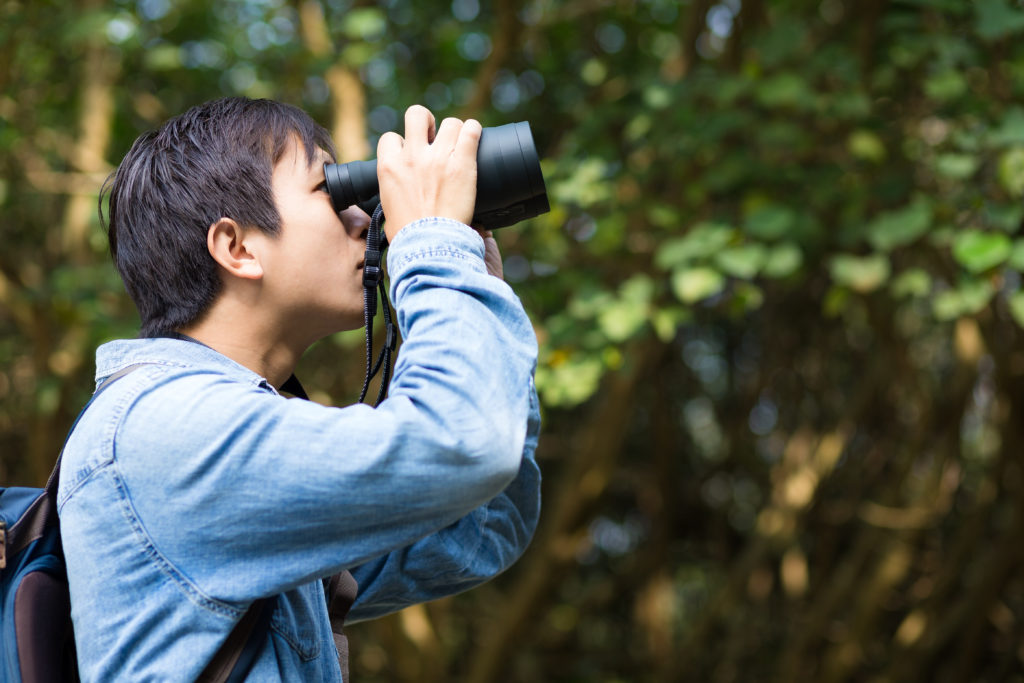
In Summary
Feeding birds in your backyard can be the gateway to a lifelong hobby and multiple adventures. Birding can also raise your quality of life right in your own home as you start to engage more fully with nature right outside your door. Giving a little bit of yourself to our fine feathered friends helps spread their joy throughout the neighborhood. This entry just scratches the surface of how to provide for our flying friends: we haven’t even discussed bird baths or bird houses!
Just a few friendly reminders:
- Do not feed bread to birds..notice that was NOT on the list of things to feed birds?
- Do not buy the cheapest seed you can find because the birds won’t eat it anyway
- Keep food fresh and plentiful
- Feed birds year round
- Keep feeders clean
- Do your best to keep away the squirrels and other rodents…but this requires constant diligence and sometimes serious engineering.
What are your favorite birds to observe? What are the most common birds that flock to your backyard? Whether you have been feeding birds for years or are just starting to scratch the surface of this hobby, it is an activity that you can do anywhere. But if you need a NEW anywhere to do it, be sure to contact your F.C. Tucker Emge REALTORS® today, and Let’s Talk!



